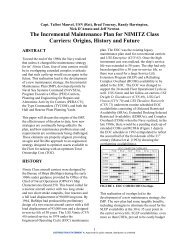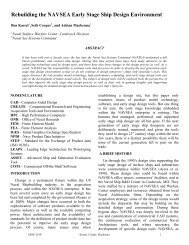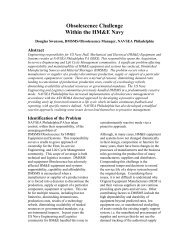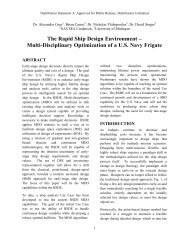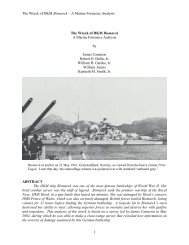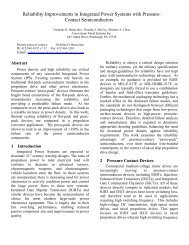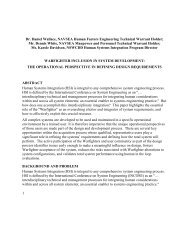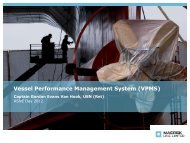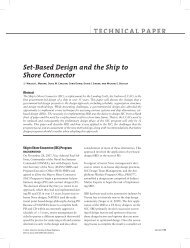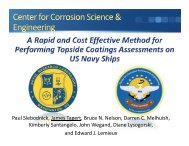Design, Manufacturing, and Testing of an Improved Watertight Door ...
Design, Manufacturing, and Testing of an Improved Watertight Door ...
Design, Manufacturing, and Testing of an Improved Watertight Door ...
You also want an ePaper? Increase the reach of your titles
YUMPU automatically turns print PDFs into web optimized ePapers that Google loves.
<strong>Design</strong>, <strong>M<strong>an</strong>ufacturing</strong>, <strong><strong>an</strong>d</strong> <strong>Testing</strong> <strong>of</strong> <strong>an</strong> <strong>Improved</strong> <strong>Watertight</strong> <strong>Door</strong><br />
Figure 11: New<br />
<strong>Watertight</strong> <strong>Door</strong><br />
Showing Holes in<br />
Stiffeners along the<br />
Neutral Axis Before<br />
Spot Welding the<br />
Face Sheet to the<br />
Stiffeners<br />
Figure 12: Automated<br />
Welding<br />
System Developed by<br />
MDL under Subcontract<br />
to ARL Penn<br />
State<br />
100 & 2010 #4<br />
WATERTIGHT DOOR DESIGN<br />
The stiffener arr<strong>an</strong>gement in the p<strong>an</strong>el <strong><strong>an</strong>d</strong> frame<br />
<strong>of</strong> the new door is illustrated in Figure 11. Extensive<br />
finite-element <strong>an</strong>alyses were carried out to<br />
ensure the structural integrity <strong>of</strong> the watertight<br />
door. They resulted in increasing the stiffener<br />
height to 1.3 in. <strong><strong>an</strong>d</strong> the face sheet thickness to<br />
0.048 in. to increase stiffness <strong><strong>an</strong>d</strong> strength. A<br />
compensating weight reduction was achieved by<br />
laser cutting holes centered on the neutral axis <strong>of</strong><br />
the stiffeners.<br />
The new watertight door was hydrostatically<br />
loaded multiple times during prototype lab testing<br />
to 15 psi pressure, <strong>an</strong> overload <strong>of</strong> 50%,<br />
without perm<strong>an</strong>ent deformation, mech<strong>an</strong>ical<br />
failure, or <strong>an</strong>y loss <strong>of</strong> functionality.<br />
The new watertight door weighed assembly including<br />
frame 213 lbs, a 27% reduction<br />
compared with the 26 in. 66 in., 10 psi<br />
NSWTD.<br />
SEAL SYSTEM<br />
Leakage at low rates ( 1–10 mL/min) was not<br />
difficult to achieve with the hydraulically actuated<br />
seal system, but the Navy requires zero<br />
leakage at 10 psi design pressure. Although presenting<br />
a great challenge, this requirement was<br />
finally satisfied in laboratory testing. Import<strong>an</strong>t<br />
issues contributing to this success included: controlling<br />
the gasket length; forming a smooth<br />
joint between the ends <strong>of</strong> the extrusion; uniform<br />
positioning <strong>of</strong> the gasket in the corners <strong>of</strong> the<br />
door; <strong><strong>an</strong>d</strong> smoothness <strong>of</strong> the gasket cavity. ARL<br />
Penn State worked closely with its supplier,<br />
Northwest Rubber Extruders, Beaverton, OR, to<br />
address these issues.<br />
A hydrostatic loading test matrix specified by<br />
NSWCCD was successfully completed, including:<br />
two frame/p<strong>an</strong>el combinations from<br />
different doors; two different gaskets; <strong><strong>an</strong>d</strong> two<br />
loading directions (repeated three times) giving a<br />
total <strong>of</strong> 2 3 3 5 24 successful tests. In each test,<br />
the door was loaded to 10 psi <strong><strong>an</strong>d</strong> held for 20<br />
minutes with no leaks whatsoever. The opening/<br />
closing (pull/push on h<strong><strong>an</strong>d</strong>le) force for the new<br />
watertight door was o2 lbs.<br />
MANUFACTURING<br />
The automated m<strong>an</strong>ufacturing system developed<br />
by MDL to m<strong>an</strong>ufacture the new watertight door<br />
is shown in Figure 12. The door was attached to a<br />
rotary stage after spot welding. Several welds<br />
were made on one side <strong><strong>an</strong>d</strong> then the door was rotated<br />
so that the thermal stresses <strong><strong>an</strong>d</strong> distortion<br />
produced by these welds could be bal<strong>an</strong>ced by<br />
making welds on the opposite side. This was continued<br />
in a specified weld sequence until the<br />
welding assembly was completed. In Figure 12,<br />
the door is shown in mid rotation with five continuous<br />
welds completed on one side.<br />
The automated welding system has demonstrated<br />
the capability <strong>of</strong> completing all<br />
continuous autogenous laser welds, approximately<br />
332 ft <strong>of</strong> welds, in 45 minutes. This<br />
automation is critical to achieve the goal to reduce<br />
the procurement cost to US$4,500 per door<br />
assembly.<br />
NAVAL ENGINEERS JOURNAL



